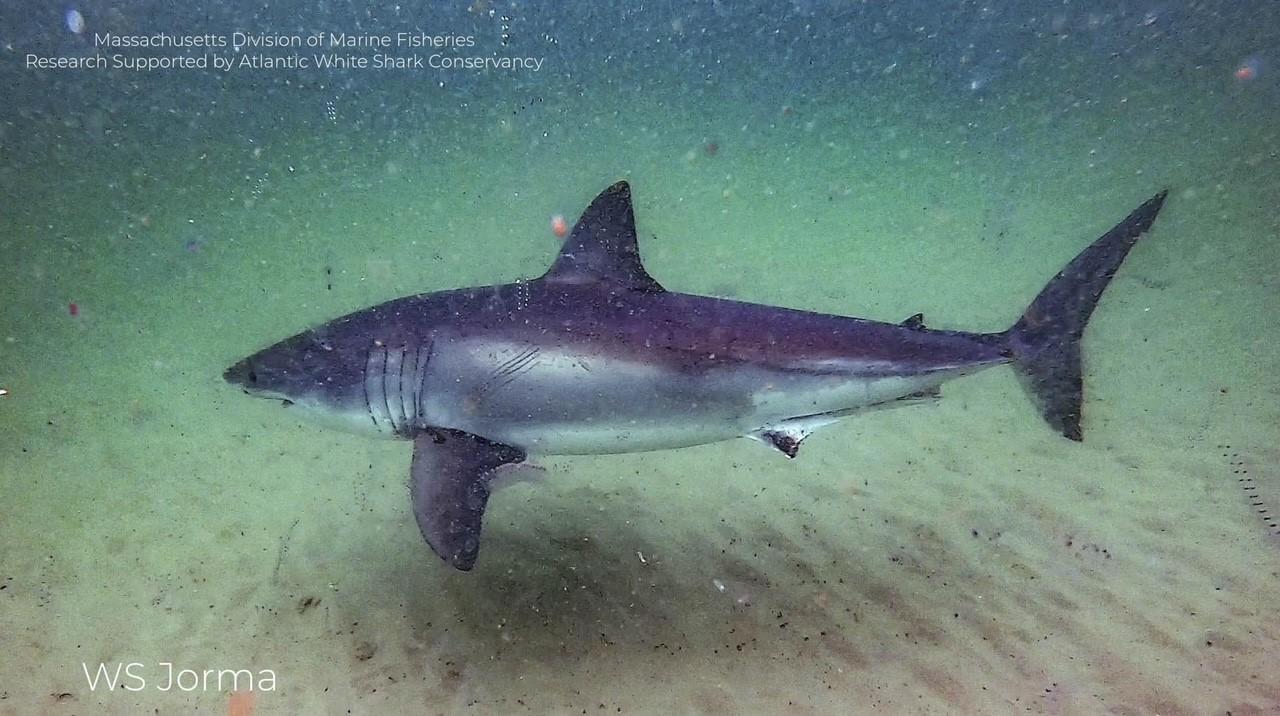- Division of Marine Fisheries

Description: The white shark (or great white shark) is a member of the family Lamnidae, which also includes the popular shortfin mako (Isurus oxyrinchus) and cold-water porbeagle (Lamna nasus) sharks. Like these closely related species, the white shark is built for speed with a streamline, torpedo-shaped body, relatively short pectoral and pelvic fins, a flattened caudal keel, and a lunate tail (lower lobe is almost the same size as the upper lobe). The white shark is differentiated from its local cousins by its coloration (gray back sharply meeting a bright white underside), relatively shorter snout and deeper body, broad triangular teeth, and overall larger size. Like the tunas, all lamnid sharks have the very unique ability to raise their body temperature above the surrounding seawater, which is rare in the fish world.
Distribution and Habitat: The white shark is found in tropical and temperate waters throughout the western North Atlantic including the Caribbean Sea, The Bahamas, the Gulf of Mexico, and along the eastern seaboard from Florida to as far north as Newfoundland, Canada. Like many fish species, the white shark migrates seasonally north and south along the eastern seaboard of the US, but also moves offshore into the oceanic waters of the Atlantic. This species arrives in Massachusetts waters as early as late April and can stay as late as mid-December, but is most common August through October.
The white shark inhabits the entire water column along the continental shelf, but is also known to approach very close to the shoreline when feeding on seals in our coastal waters. When the species moves off the shelf into oceanic waters, it dives as deep as 3700 feet through a very broad temperature range of 35-87°F. The white shark is not a schooling fish and is most often observed as solitary individuals.
Life History: The white shark is considered a generalist that feeds a variety of species. Small white sharks from the size at birth to about nine feet in length are built for speed and agility. They are relatively slim, like mako sharks, and well-adapted for feeding on schooling fish, squid, and other sharks. The teeth of small white sharks are relatively long and narrow and perfect for grasping prey like small fishes. As white sharks get larger than eight feet, their body shape gets bulkier as their muscle mass increases and their tooth shape become broader and more triangular, which is ideal for cutting and gouging pieces from prey too large to swallow whole. Using speed and powerful jaws, these larger white sharks are now capable of attacking and killing animals including seals, dolphins, and porpoises. They are also capable of tearing large chunks of blubber and muscle from dead whale carcasses, which they opportunistically scavenge.
When in Massachusetts waters, small white sharks are known to feed on striped bass, while larger sharks are observed targeting seals off the Outer Cape or scavenging humpback, minke, and right whales.
In the North Atlantic, the white shark grows very slowly and is thought to live in excess of 70 years. Males and females do not mature until they are in the late twenties and reach lengths of 12 and 15 feet, respectively. When it comes to white sharks, maximum size tends to be exaggerated with reports greater than at 25 or 30 feet. In reality, the largest reliably measured white shark was 19 feet, 9 inches and over 5,000 lbs. Off the coast of Massachusetts, white sharks as large as 18 feet have been observed by DMF biologists.
The reproductive biology of the white shark is poorly understood. In the western North Atlantic, it is not known when or where males mate with females. Gestation in this species is thought to be more than a year and females give birth to between five and ten pups, but as many as 17 have been found in pregnant females. Newborn white sharks are about 4 to 5 feet in length and fully capable of surviving without parental care. Although it is not known where or when females give birth to their young, the smallest white sharks appear on the continental shelf between New Jersey and Massachusetts in the summer months. This region is considered a white shark nursery.
Management: There is no stock assessment for white sharks in the western North Atlantic, but working with MarineFisheries, the Atlantic White Shark Conservancy has cataloged more than 600 individuals off the coast of Cape Cod over the last decade (White Shark Logbook (atlanticwhiteshark.org)). The best available data indicate that the white shark population is rebounding after being overexploited during the 1980’s and 1990’s. In 1997, the National Marine Fisheries Service designated the white shark a prohibited shark species, which means that it cannot be harvested and retained. In 2005, MarineFisheries followed suit and designated the white shark a prohibited species. With the increase in white shark abundance in our coastal waters over the last decade, MarineFisheries adopted additional regulations in 2015 to prohibit the attraction, capture, and tagging of white sharks in state waters without a special white shark permit.
On an international scale, the white shark is listed on Appendix II by the Convention on International Trade of Endangered Species of Wild Fauna and Flora (CITES), which regulates the trade of this species - to export white sharks or white shark parts, a CITES permit is required. In addition, the white shark is listed on both Appendix I and II of the Convention on Migratory Species (CMS), an environmental treaty of the United Nations specializing in the conservation of migratory species. The Appendix I listing means that the white shark is threatened with extinction and CMS countries must work to protect this species, its habitat, migration pathways, and any other factors that might endanger them. The CMS Appendix II listing means that white sharks would significantly benefit from international agreements for their conservation and management.
By Dr. Greg Skomal, Recreational Fisheries Program Manager
